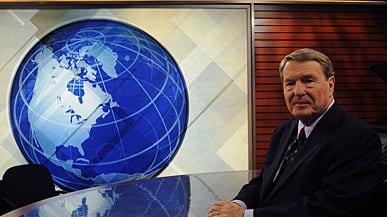I find Jim Lehrer’s manner of withdrawing as chief anchor of the PBS NewsHour quite remarkable because I can’t recall any news anchor doing it as he has.
First, he took his name off the program. Has anyone ever done that before? Voluntarily? In December 2009, with his full approval, the program ceased being The NewsHour with Jim Lehrer and became The PBS NewsHour. It was a ground-breaking moment. It ratified the NewsHour’s position anchoring the PBS evening program schedule. It helped further to fix the PBS identity in the public mind, enhancing the brand name, and it recognized the unique freedom and support public broadcasting gave us in creating an alternative form of television journalism and building an audience for it.
So, Jim took his name off the program. But no one made him do that. He was not being pushed out. There was no clutch of network execs saying it was time for him to go; no secret market research to find a young hot shot from the TV hinterland; no Vice President of Interior Decorating (as they used to say at the networks) already concocting a new set. The PBS execs love Lehrer and so does the audience.
It happened because for several years Lehrer has been presiding over a steady but subtle rebirth of the NewsHour, in the process gradually handing over the journalistic and anchor responsibilities.
Instead of shopping for a new bright star, he’s encouraged the emergence of a team of colleagues who increasingly share the anchor duties, as well as field reporting. Now the NewsHour works like a repertory company in the theater, with different correspondents coming forward to take the lead part or share it with another on different nights. And as Jim has gradually subtracted himself from anchor duties, the individual correspondents have emerged, each with more space giving individual personalities and particular skills more breathing room. And they have blossomed—Gwen Ifill, Judy Woodruff, Jeff Brown, Margaret Warner, and Ray Suarez. So what the NewsHour can now boast is a family of seasoned professionals, each personality contributing to the total personality of the program, their collective presence constituting the feel and tone of the program known by its devoted viewers.
It’s the most constructive and graceful exit strategy I have ever seen for someone holding a coveted and senior position in today’s media.
So, what Jim has achieved with the collaboration of Linda Winslow, the executive producer, is anchor replacement by stealth, without the hoopla and speculation that usually accompanies the enthronements and dethronements of these kings and queens of our media culture. No nightly news program to my knowledge has ever done this before. And none has dared to replace the iconic anchor role with a rotating team like this. Thus his replacement cast is in place, recognized and trusted by the viewers.

Jim has thus been able to bequeath the most precious commodity in journalism, the enormous trust and credibility he has inspired over the years. That cannot simply be passed on like a parking space or a key to the restroom.
Under Jim’s leadership, many surveys show, the NewsHour, has acquired a unique place of trust for the American public.
It starts with fairness. I used to think myself a pretty fair-minded journalist, until I discovered that Jim’s sense of fairness was fuller and fiercer than mine and it was his we adopted to make fairness a fundamental goal of our nightly program, No other journalist has been chosen by all participants to moderate presidential debates as often as Jim—11 times, an all time record. He has not only moderated the debates but been admired enough by the candidates—winners and losers—to be asked back to hear their views for a special about those pivotal moments in our democracy. Now, Jim has added his own behind-the-scenes thrills and chills in the book Tension City to be published in September.
Jim’s sense of fairness is distilled in the personal code of conduct that he lives and works by as a journalist.
This is how he outlined it recently in a talk at the National Press Club in Washington:
1. DO NOTHING I CAN NOT DEFEND... 2. COVER, WRITE AND PRESENT EVERY STORY WITH THE CARE I WOULD WANT IF THE STORY WERE ABOUT ME... 3. ASSUME THERE IS AT LEAST ONE OTHER SIDE OR VERSION TO EVERY STORY... 4. ASSUME THE VIEWER IS AS SMART AND CARING AND GOOD A PERSON AS I AM... 5. ASSUME THE SAME ABOUT ALL PEOPLE ON WHOM I REPORT... 6. ASSUME PERSONAL LIVES ARE A PRIVATE MATTER UNTIL A LEGITIMATE TURN IN THE STORY ABSOLUTELY MANDATES OTHERWISE... 7. CAREFULLY SEPARATE OPINION AND ANALYSIS FROM STRAIGHT NEWS STORIES... AND CLEARLY LABEL EVERYTHING... 8. DO NOT USE ANONYMOUS SOURCES OR BLIND QUOTES, EXCEPT ON RARE AND MONUMENTAL OCCASIONS. NO ONE SHOULD EVER BE ALLOWED TO ATTACK ANOTHER ANONYMOUSLY... 9. AND... FINALLY... I AM NOT IN THE ENTERTAINMENT BUSINESS...
Regular viewers of the PBS NewsHour—along with visitors to its website—see those principles in action every night.
Now, by osmosis, viewers can be confident that each member of the NewsHour team will continue to practice the kind of journalism Jim has instilled.
But that bestowal of trust is just one way in which Jim has prepared the NewsHour for a future in the digital age.
On the day that the program first appeared under its new title, the PBS NewsHour, in December, 2009, it also fully integrated the television program with the Online NewsHour. It introduced a new leader for the online operation, and a face for its presentation, Hari Sreenivasan. Now all editorial staff on the program—correspondents, reporters, producers, editors, desk assistants, production assistants—work with equal determination for what goes out on the Internet and what appears on the air.
Some of us weaned in other generations of journalism worry that in the seeming hurricane of new developments—where anyone with a cellphone can virtually become a journalist—the best values of the old journalism will disappear in the increasingly viral and anarchical blogosphere. But having the NewsHour move so forcefully online, ensures that its trusted journalistic values can help to shape this scary yet exhilarating new world.
All this has been accomplished while adjusting to new realities that affect all broadcasters—rising costs and less certain revenues. While commercial rivals in the news business struggle to capture eyeballs to attract advertisers, public broadcasting struggles for funding from government, from viewers, from corporations and foundations. All sources face so splintered a media world that the charitable pie is cut into smaller and smaller slices. The NewsHour has its loyal and generous donors but nurturing them and finding others requires constant effort. The program has been able to keep its nose just above water financially. That has been achieved in part by learning how to use the new technology to do things more cheaply, like transmitting reports from overseas by Internet instead of satellites.
So that is the quiet but important revolution Jim Lehrer has guided while gracefully extracting himself from the most visible and public role. It’s the most constructive and graceful exit strategy I have ever seen for someone holding a coveted and senior position in today’s media. It guarantees a continued place in today’s bewildering media spectrum for a program that will stay devoted to serious journalism.
I know Jim very well. We have been colleagues, friends and business partners for decades now, and I salute him for how he is handling his exit by stealth.
Robert MacNeil is a novelist and the former co-anchor and co-founder of The MacNeil/Lehrer Report.






